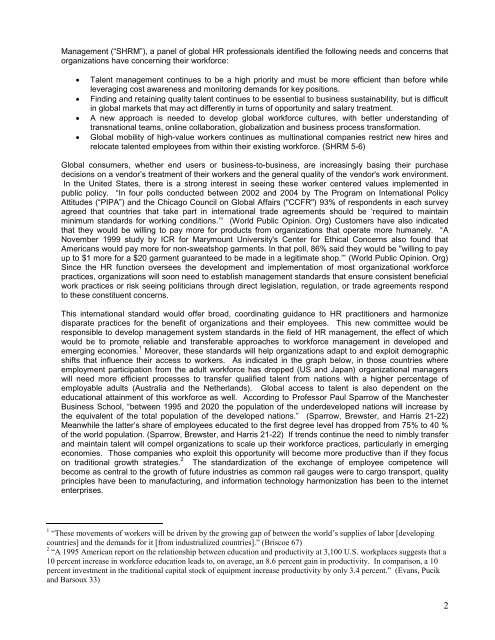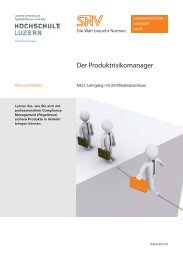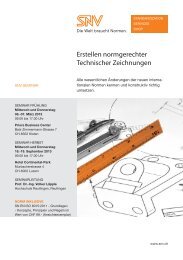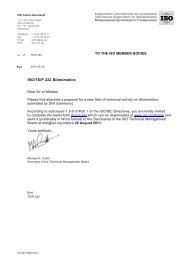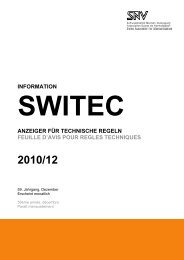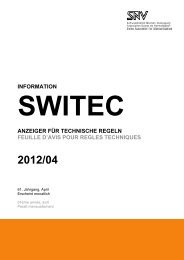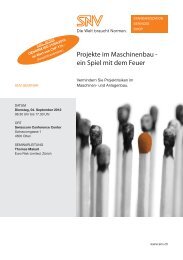ISO/TC 260 N 2 - SNV
ISO/TC 260 N 2 - SNV
ISO/TC 260 N 2 - SNV
- No tags were found...
You also want an ePaper? Increase the reach of your titles
YUMPU automatically turns print PDFs into web optimized ePapers that Google loves.
Management (“SHRM”), a panel of global HR professionals identified the following needs and concerns thatorganizations have concerning their workforce:Talent management continues to be a high priority and must be more efficient than before whileleveraging cost awareness and monitoring demands for key positions.Finding and retaining quality talent continues to be essential to business sustainability, but is difficultin global markets that may act differently in turns of opportunity and salary treatment.A new approach is needed to develop global workforce cultures, with better understanding oftransnational teams, online collaboration, globalization and business process transformation.Global mobility of high-value workers continues as multinational companies restrict new hires andrelocate talented employees from within their existing workforce. (SHRM 5-6)Global consumers, whether end users or business-to-business, are increasingly basing their purchasedecisions on a vendor‟s treatment of their workers and the general quality of the vendor's work environment.In the United States, there is a strong interest in seeing these worker centered values implemented inpublic policy. “In four polls conducted between 2002 and 2004 by The Program on International PolicyAttitudes (“PIPA”) and the Chicago Council on Global Affairs ("CCFR") 93% of respondents in each surveyagreed that countries that take part in international trade agreements should be „required to maintainminimum standards for working conditions.‟” (World Public Opinion. Org) Customers have also indicatedthat they would be willing to pay more for products from organizations that operate more humanely. “ANovember 1999 study by ICR for Marymount University's Center for Ethical Concerns also found thatAmericans would pay more for non-sweatshop garments. In that poll, 86% said they would be "willing to payup to $1 more for a $20 garment guaranteed to be made in a legitimate shop.‟” (World Public Opinion. Org)Since the HR function oversees the development and implementation of most organizational workforcepractices, organizations will soon need to establish management standards that ensure consistent beneficialwork practices or risk seeing politicians through direct legislation, regulation, or trade agreements respondto these constituent concerns.This international standard would offer broad, coordinating guidance to HR practitioners and harmonizedisparate practices for the benefit of organizations and their employees. This new committee would beresponsible to develop management system standards in the field of HR management, the effect of whichwould be to promote reliable and transferable approaches to workforce management in developed andemerging economies. 1 Moreover, these standards will help organizations adapt to and exploit demographicshifts that influence their access to workers. As indicated in the graph below, in those countries whereemployment participation from the adult workforce has dropped (US and Japan) organizational managerswill need more efficient processes to transfer qualified talent from nations with a higher percentage ofemployable adults (Australia and the Netherlands). Global access to talent is also dependent on theeducational attainment of this workforce as well. According to Professor Paul Sparrow of the ManchesterBusiness School, “between 1995 and 2020 the population of the underdeveloped nations will increase bythe equivalent of the total population of the developed nations.” (Sparrow, Brewster, and Harris 21-22)Meanwhile the latter‟s share of employees educated to the first degree level has dropped from 75% to 40 %of the world population. (Sparrow, Brewster, and Harris 21-22) If trends continue the need to nimbly transferand maintain talent will compel organizations to scale up their workforce practices, particularly in emergingeconomies. Those companies who exploit this opportunity will become more productive than if they focuson traditional growth strategies. 2 The standardization of the exchange of employee competence willbecome as central to the growth of future industries as common rail gauges were to cargo transport, qualityprinciples have been to manufacturing, and information technology harmonization has been to the internetenterprises.1 “These movements of workers will be driven by the growing gap of between the world’s supplies of labor [developingcountries] and the demands for it [from industrialized countries].” (Briscoe 67)2 “A 1995 American report on the relationship between education and productivity at 3,100 U.S. workplaces suggests that a10 percent increase in workforce education leads to, on average, an 8.6 percent gain in productivity. In comparison, a 10percent investment in the traditional capital stock of equipment increase productivity by only 3.4 percent.” (Evans, Pucikand Barsoux 33)2


